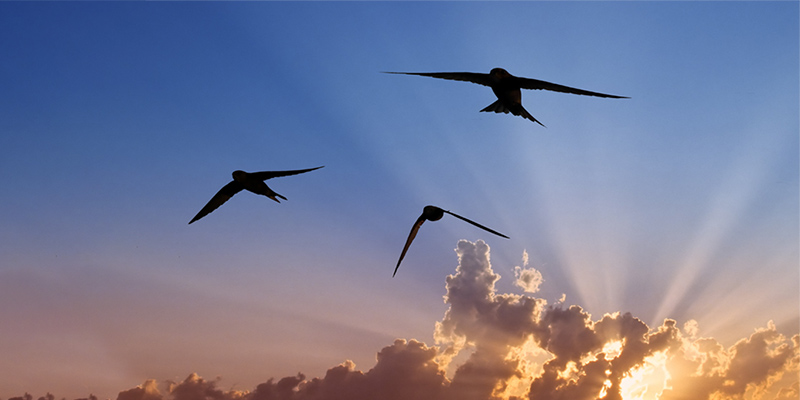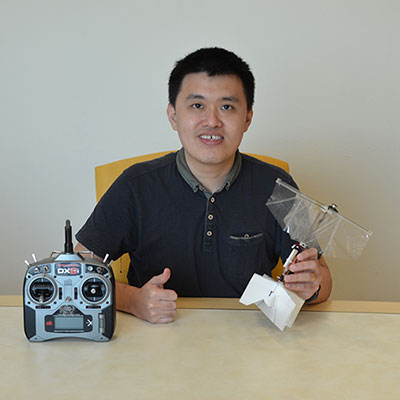Is it a bird, a plane? Not superman, but a flapping wing drone
By Candy Gibson
 TECHNOLOGY AND ENGINEERING Swifts are the inspiration for the flapping wing drone.
TECHNOLOGY AND ENGINEERING Swifts are the inspiration for the flapping wing drone.A drone prototype that mimics the aerobatic manoeuvres of one of the world’s fastest birds, the swift, is being developed by an international team of aerospace engineers in the latest example of biologically inspired flight.
A research team from South Australia, Singapore, China and Taiwan has designed a 26 gram ornithopter (flapping wing aircraft) which can hover, dart, glide, brake and dive just like a swift, making them more versatile, safer and quieter than existing quadcopter drones.
Weighing the equivalent of two tablespoons of flour, the flapping wing drone has been optimised to fly in cluttered environments near humans, with the ability to glide, hover at very low power, and stop quickly from fast speeds, avoiding collisions – all things that quadcopters can’t do.
The team, which includes UniSA aerospace engineer Professor Javaan Chahl, has designed a flapping wing drone similar in size to a swift, or large moth, that can perform some aggressive bird flight manoeuvres.
Prof Chahl says copying the design of birds, such as swifts, is just one strategy to improve the flight performance of flapping wing drones.
“There are existing ornithopters but, until now, they were too inefficient and slow to be agile. We have overcome these issues with our flapping wing prototype, achieving the same thrust generated by a propeller,” Prof Chahl says.
“Flapping wings can lift like an aeroplane wing, while making thrust like a propeller and braking like a parachute. We have put this together to replicate the aggressive flight patterns of birds by simple tail control.”
 Dr Yao-Wei Chin with the flapping wing drone prototype.
Dr Yao-Wei Chin with the flapping wing drone prototype.National University of Singapore research scientist, Dr Yao-Wei Chin, who has led the project published in Science Robotics, says the biologically-inspired drones could be used successfully in a range of environments.
The surveillance applications are clear, but novel applications include pollination of indoor vertical farms without damaging dense vegetation, unlike the rotary-propelled quadcopters whose blades risk shredding crops.
Because of their stability in strong winds, the ornithopter drone could also be used to chase birds away from airports, reducing the risk of them getting sucked into jet engines.
“The optimised ornithopter acts as a kind of scarecrow, greatly saving on labour costs for pest control companies and airport operators,” Dr Chin says.
There are currently no commercialised ornithopters being used for surveillance, but this could change with the latest breakthrough, researchers say.
By improving the design so ornithopters can produce enough thrust to hover and to carry a camera and accompanying electronics, the flapping wing drone could be used for crowd and traffic monitoring, information gathering and surveying forests and wildlife.
The light weight and slow beating wings of the ornithopter pose less danger to the public than quadcopter drones in the event of a crash and given sufficient thrust and power banks it could be modified to carry different payloads depending on what is required.
One area that requires more research is how birds will react to a mechanical flying object resembling them in size and shape. Small, domesticated birds are easily scared by drones but large flocks and much bigger birds have been known to attack ornithopters.
And while the bio-inspired breakthrough is impressive, we are a long way from replicating biological flight, Dr Chin says.
“Although ornithopters are the closest to biological flight with their flapping wing propulsion, birds and insects have multiple sets of muscles which enable them to fly incredibly fast, fold their wings, twist, open feather slots and save energy.
“Their wing agility allows them to turn their body in mid-air while still flapping at different speeds and angles.
“Common swifts can cruise at a maximum speed of 31 metres a second, equivalent to 112 kilometres per hour or 90 miles per hour.
“At most, I would say we are replicating 10 per cent of biological flight,” he says.
Efficient flapping wing drone arrests high speed flight using post-stall soaring is published in Science Robotics. The project was a culmination of PhD work done by Dr Yao-Wei Chin at Nanyang Technological University under the guidance of Associate Professor Gih-Keong Lau (now with National Chiao Tung University, Taiwan), and an international collaboration comprising Professor Boo Cheong Khoo (National University of Singapore), Professor Javaan Chahl and Dr Jia Ming Kok (University of South Australia and Defence Science and Technology Group, Australia), Dr Yong-Qiang Zhu (Qingdao University of Technology, China) and Dr Woei Leong Chan (National University of Singapore).
Other Stories
- 35-second body scan could tell you the sport you’re best suited to
- Insects inspire infection resistant dental implants
- Is it a bird, a plane? Not superman, but a flapping wing drone
- Could our beloved Aussie rules footy be turning into soccer?
- From the Vice Chancellor
- Achievements and Announcements
- Health students step up to the plate to help curb Australia’s $170b medical bill
- Remote internships providing students with rewarding experiences
- Video: How to keep your brain healthy
- Which is more creative, the arts or the sciences?
- Local partnership delivers world-leading ‘smarts’ to shipbuilding
- MBA student creates Australia’s most eco-friendly magazine wrap
- Pandemic prompts students to solve challenges creatively
- The latest books from UniSA researchers
- In Pictures: Open August and VC Excellence Awards online event



